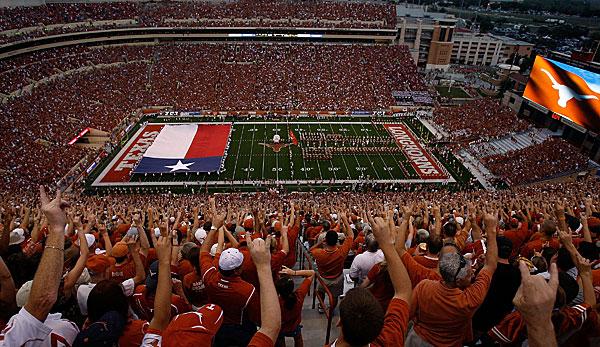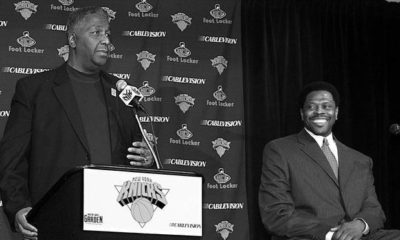US-Sport
Theme week: Theme week: Money, scandals, hope – a lot is at stake
The phenomenon of college football is one of the most admirable in the entire sports world. Up to 100,000 spectators attend the games, the atmosphere during the Saturday afternoons is outstanding and the universities record high revenues. But behind the façade some unattractive side effects are hidden. SPOX gives an insight into the fascinating world of college football as part of a theme week.
The United States is obsessed with sport. Their sports are local and the support of the teams mostly local. And where professional sport cannot find its way due to a lack of lucrative prospects, college sport is often number one.
The university teams are highly regarded in their cities, towns and regions. Not only for students currently attending the university, but also for graduates who crossed the same campus generations ago and then passed on their passion to their children.
Stadiums with a capacity of over 100,000 seats are filled on Saturdays in the second half of the year. The athletes in the college teams are celebrated superstars. Only their fans read reports on their smartphone about players they often run into every day. Stand in the same refectory queue in front of the food counter, study in the same library and sit in the same lecture hall.
College fans also don’t have to worry about the unpleasant thought that the person to whom they are entrusting their hope for the right outcome of the game is an overpaid settler who will earn more money within a year than the fan in his whole life. College players are hometown heroes and that no matter where they really come from.
If you take a look at L.A., for example, it’s not the rams that have just returned and certainly not the chargers from the NFL that the local community prefers. Instead, the USC Trojans and UCLA Bruins have established themselves as the most sought-after teams in the region during the decades without the NFL team in LA. And while these college teams are being debated in the local media and on sports radio, like the New England Patriots in Boston, the Rams and Chargers are struggling to get a fan base up and running.
College football. This is where American sports fans spend their Saturdays in autumn. He gives people a connection to their family and the community. It is a fascination and a spectacle that can quickly cast a spell on you – and on which much more depends than just the games on Saturday.
Football is America’s number one sport and accordingly the sport is also present in the country’s children’s rooms. Young people dream of one day becoming football pros and playing like role models in the big NFL. The way there is clear. In the best case scenario, the best way to get into professional football is to go through high school with a college scholarship. However, this is by no means a matter of course.
Only three to four percent of all high school players enjoy the privilege of a scholarship and the chance to play Division 1 football in college at the same time. And this although there are more scholarships in the sport than in any other. A total of 850 colleges offer football programs and over 80,000 players are active in college football teams.
For high school players with such intentions, the recruitment process starts very early; players who want to get into the shop window do everything they can to get one of these scholarships. Schools that want to have the most sought-after talents sometimes make an unbelievable effort to convince the talent of themselves. In the end, the entire nation awaits the National Signing Day.
Some high school players are discovered because their coaches promote them. Others by standing out by chance on another player’s tape. Again others convince during camps. In any case, it all starts right after entering Senior High School.
Good high school coaches send tapes from their best players to colleges, but sometimes family members or friends do. The players are then promoted with the highlight tapes, also known from YouTube videos, in order to arouse the interest of the schools and convince them of a visit.
If the greater interest is on the other hand, the schools always want to remember the talent. They write letters to remind us how prestigious the school is. Many of them: 4-star talent Alvin Kamara is said to have received 105 letters from the University of Alabama in one day.
The talents are unofficially invited to visit the universities. Campus and facility tours as well as discussions with current players from the squad and the coaching staff are intended to butter their mouths. Sometimes with a visit to a game of the basketball team.
In the end, however, it all comes down to the final talks. Some talents and their families want to hear the right things about the education program. Others are concerned about time or position in the team – Lamar Jackson, for example, is said to have picked up a promise from the Louisville coaches that he would be employed as quarterback and not in another position. It’s a bit like marketing: you have to recognize the needs you want. Good recruiters recognize these and bet on them until the decision about the talent has finally been made.
The day when the talents finally announce their decision is one of the most exciting in the college football calendar. Until the talents have made their written promise, any verbal promise can be worthless.
The competition between the top schools is now getting worse. Fans find out which players will accompany and support them side by side during their college careers, and of course this is also an established food for the media landscape to attract audiences to the TV sets.
For the talents, the National Signing Day is the end of a chapter of a long and arduous transition phase. The choice of the wrong college has already cost some number one recruits an NFL career they believed to be safe. Choosing the best and most appropriate situation could be the first step in a glorious career and the star life these teenagers dream of.
Fame and celebrity. First and foremost, the very large colleges can offer this. Stadiums with up to 100,000 seats and training and indoor facilities that are in no way inferior to those of the professional football teams from the NFL. An almost unbelievable picture, with the idea that there is talk of schools and training centres.
College football is an enticing market. Not only for traditional reasons is a football program almost a must for the multitude of schools. There are several billion dollars in circulation on the market. The view of the infrastructure of so many teams absolutely reflects this.
But the reality is different. Between 2005 and 2009, there were just seven colleges whose sports programs generated a positive operating result in one year, mainly thanks to donations, ticket sales, royalties, sponsorship and TV contracts. In 2013 there were at least 20 of them, and as a reminder: 850 colleges alone offer a football programme.
The average loss of a college from the Power 5 conferences was $2.3 million. According to a study by the NCAA, the average loss of all other schools with a football programme in 2013 was 17.6 million dollars.
University of Texas
latest figures released by NCAA
But how do schools finance the programme? In order to continue to participate as part of the most important entertainment for colleges, the schools receive help from the NCAA. They are dependent on so-called “allocated revenues”, which the association can spend thanks to its general income, student fees and with the help of state funds. In other words, many colleges subsidize their sports programs, and this in part to frighteningly high proportions.
And while schools continue to spend a lot of money on infrastructure upgrades and coaching staff salaries – salaries for top coaches are currently already in excess of $5 million and rising – it also happens that the college’s less prestigious sports programmes are sometimes cancelled.
College sports can have great value in creating a great atmosphere in the community. However, only very few colleges manage to reap the fruits of the program with such a high social status on the one hand, without leaving enormous costs for their schools on the other.
Page 1: Recruitment, infrastructure and huge financial holes
Page 2: Career prospects, health risks and numerous scandals


















You must be logged in to post a comment Login